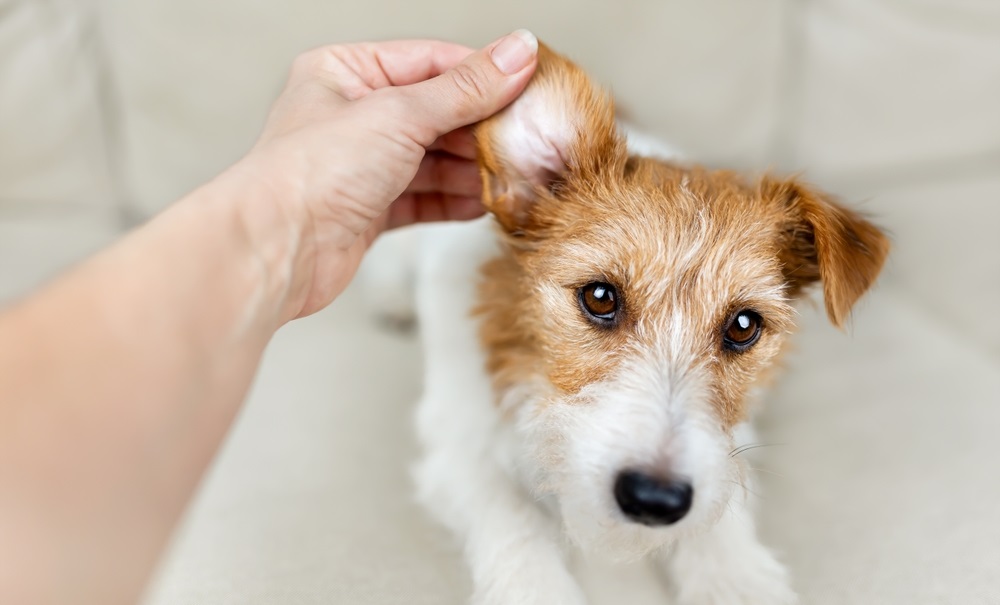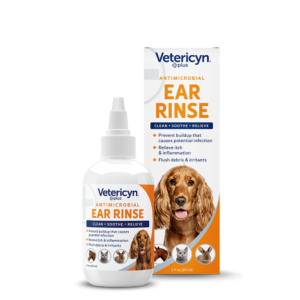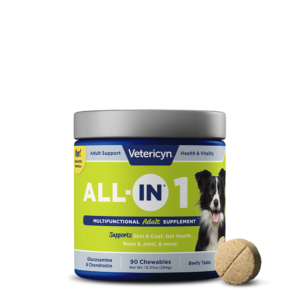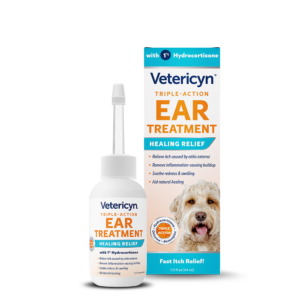From slobbery kisses to mad dashes after squirrels, dogs are usually pretty predictable. It’s why we love them. But that’s also why a disruption to their routine feels so jarring.
For example, you notice your pup looking flustered and pawing relentlessly at their ear. You investigate the skin and spot a swollen red mass looming beneath your pooch’s floppy ears. You’ve got an ear hematoma on your hands.
Ear hematomas in dogs may look alarming, but fear not! Although they usually require vet attention, there’s plenty you can do to soothe and subdue them from home, especially if your dog’s ear is swollen and puffy and needs relief fast.
What Is an Ear Hematoma?
Before learning how to treat a dog ear hematoma at home, you need to know what you’re dealing with.
Hematomas (sometimes called “blood blisters”) happen when blood pools inside a single organ or tissue.1 A prime example: bruising.
As opposed to injuries like cuts, where blood seeps out through the broken skin, hematomas are internal wounds that allow blood to gather beneath the skin. A dog ear hematoma occurs when a blood pocket forms under your pup’s ear flap. As the blood congregates, the ear flap grows puffed up and spongy.
Sometimes, the entire ear will swell. Other times, it only affects a specific section. Either way, you must address ear hematomas promptly.
Signs of an Ear Hematoma
Dogs can experience a number of ear troubles, so it’s important to know the hematoma red flags.
In addition to swelling that often resembles a grape or inflated balloon, when your pup has an ear hematoma, you’ll usually notice2:
- Incessant head shaking
- Spongy texture to the ear
- Crusty, gunky discharge
- Redness and irritation
- Ear skin that’s hot to the touch
All dog breeds can experience a hematoma, but our beloved floppy-eared friends are the most susceptible. When tossed, longer ears also have more of a “whipping” effect, which can crank up the damage.
What Causes Ear Hematomas?
Dog ears feature a layer of cartilage encased by thin, sensitive skin. Blood vessels galore run under the surface, mostly unprotected from external trauma (as opposed to vessels that lie beneath thick fur and sturdy torso skin).
When a dog’s ear itches or aches, they can’t resist giving their head a good, hard shake or an aggressive scratch. While these movements might offer momentary relief, they also threaten the sensitive blood vessels winding through the ears.
With excessive shaking, these vessels start to break, and blood flows into the narrow space between the skin and inner cartilage. With nowhere to drain, the blood pushes against the skin and produces visible surface swelling.
The more damage occurs, the more achy and swollen your poor pup’s hematoma becomes.

Can You Treat Dog Ear Hematomas at Home?
It’s tough to watch your pup mope and scratch, and even tougher to watch their hematoma swell bigger and bigger. Naturally, you want to do all you can to soothe your dog’s discomfort—but can it happen at home?
For milder hematomas, yes. You have several treatments at your disposal:
- Applying cold/warm compresses – The best thing you can do for your dog’s ear hematoma is to encourage the trapped blood to drain. Warm compresses loosen clotted fluid and elevate blood flow, while cold compresses soothe inflammation and ease discomfort.
- Using “the cone” – Yep, the dreaded Elizabethan collar. While pups won’t always appreciate their new Shakespearian duds, an E-collar can prevent further shaking and scratching, granting the ear time to heal.
- Monitoring symptoms — Many hematomas will deflate on their own if given time and space. But they can easily worsen and require medical attention. Keep a close eye on your dog’s symptoms. If swelling increases or you notice signs of “cauliflower ear,” call the vet.
More serious ear hematomas require special treatment. This usually entails:
- Surgery to drain trapped blood.
- Suturing of the affected area to heal the “pocket.”
- Bandaging of the affected area which promotes stability and prevents scarring.
Your vet will typically offer a post-operative recovery regimen consisting of rest, pain meds, and follow-up appointments.
Above all, never attempt to drain a hematoma at home. This can trigger infection and further injury.
Even though most hematomas heal on their own, the tissue still absorbs damage in the process, and its cauliflower-esque texture can block the ear canal. And, let’s face it, keeping your pup from head shaking is a Herculean task.
Can Dog Ear Hematomas Heal Without Treatment?
In some cases, minor ear hematomas in dogs may reabsorb over time without medical intervention, but this comes with a catch.
While the blood may drain naturally, the ear can become misshapen due to internal scarring. This “cauliflower ear” can interfere with hearing, trap debris, and increase the risk of ear infection down the road.
Leaving a hematoma untreated might save a trip to the vet now, but it could result in chronic ear problems later.
Itching and Irritation: The Real Culprit
While head shaking and broken blood vessels lead directly to ear hematomas, itchy and inflamed ears cause troublesome head shaking in the first place. Diligent dog owners can prevent ear hematomas from popping up by addressing irritation before it balloons into a larger issue—literally.
Keeping your dog’s ears spick-and-span is the best medicine, especially since all sorts of dog ear problems can produce aural hematomas if left untreated. These include:
- Yeast infections – Dogs have long, L-shaped ear canals. Given this rigid shape, the canal often traps fluid and other debris. This stagnant buildup can lead to bacterial infections that spread to the outer ear. Yeast infections are incredibly itchy, and head shaking is inevitable.3
- Allergies – Dogs can suffer from seasonal and food allergies that tax the immune system. With diminished defenses, bacteria have an easier time taking root beneath warm, moist ear flaps.
- Foreign objects – Many dogs will fearlessly charge through tall brush in pursuit of a wayward ball or a speedy critter. Unfortunately, these adventures can trap objects like grass seeds and pollen within the ear canal, leading to itchy inflammation.
- Ear mites – The bane of a pup’s carefree existence, dog ear mites love to make themselves at home within the cozy confines of dogs’ ear canals. Their signature symptom? Relentless itching.
- Bacterial infections – Trapped moisture breeds bacteria. If water enters the ear after swimming or running in the rain, it can stew in the heat and dark and soon become home to a bacteria colony.
While each of these maladies presents slightly different symptoms, all of them invite scratching, pawing, and head-shaking. If left unaddressed, the relentless impact can lead to broken blood vessels—and an unsightly hematoma.
In general: stop the itching, and you’ll halt a hematoma in its tracks.
How to Maintain Healthy Ears
Keeping your pup’s ears irritant-free—that’s the name of the game. To do so, you should regularly clean your dog’s ears. Here’s how:
- Select a high-quality rinse – The Vetericyn Plus Antimicrobial Ear Rinse offers a simple and effective way to flush out irritants.
- Pull back the ear flap – Do so gently. Hold it straight as this helps open the ear canal.
- Add rinse – Slowly and carefully pour Vetericyn Ear Rinse into the canal. Continue until you’ve filled the entire space.
- Massage the ear – The rhythmic motion helps break up wax and detritus gently. Go easy if your pup’s already struggling with an achy ear.
- Allow them to shake – In this one case, head shaking is okay. It ensures the rinse finds its way out.
- Pat down the area — Gently dry the area surrounding the ear, taking extra care if your dog sports thick fur or ultra-floppy ears. No moisture should be left behind.
For best results, aim for monthly cleanings. Up the frequency to every couple of weeks for floppy-eared breeds or pooches that regularly deal with infections.4
When problems do pop up (don’t worry, it can happen to even the most vigilant dog owners), treat the itching with Vetericyn Triple-Action Ear Treatment. Fortified with 1% hydrocortisone (a potent anti-itch defense), it soothes irritation from external ear infections and helps remove accumulated debris.
Pristine, itch-free ears keep your dog focused on fetching and fun, not on head shaking. At the end of the day, that’s what pooches and paw parents want, right?
In addition to regular cleaning, keep ears in prime condition by:
- Drying after bathing or swimming – Also, try plugging their ears with cotton balls before water activities.
- Keeping ear hair groomed and clean – Dirty ear hair offers a promising springboard for nasty bacteria and critters to enter the ear canal.
- Giving your dog’s ears the occasional sniff – It might seem weird at first, but infected ears emit a stinky stench. Stay ahead of trouble by smelling once in a while.
- Watching for symptoms – These include head shaking, discharge, crusty skin, and ear canal swelling.
It’s also a good practice (for ear infections and other health issues) to schedule regular vet checkups, ideally once a year. An expert pair of eyes may spot looming red flags before they have a chance to blossom into full-blown emergencies.

When to See a Vet for a Dog Ear Hematoma
While minor hematomas can often be resolved at home with diligent care, some signs signal it’s time for professional help. Delaying treatment can lead to scarring, chronic ear damage, or recurring issues.
Consult your vet immediately if you notice:
- Rapidly increasing swelling
- Signs of extreme pain or sensitivity
- A hematoma that persists longer than a week
- Visible deformity or thickening of the ear (“cauliflower ear”)
- Behavioral changes like lethargy or loss of appetite
In these cases, your vet can assess whether surgical drainage, medication, or other interventions are necessary. Fast action means better healing and fewer complications.
Vetericyn: Music to a Pup’s Ears
Alongside swishy tails (and cuddle-me eyes), floppy ears are one of the most adorable canine features. But those ears make a happy home for infections and painful hematomas.
At Vetericyn, we offer everything you need to ward off hematomas and other ear troubles. Our precision-formulated pet ear care products keep ears in pristine shape, irritant-free, and tuned to the sound of the kibble as it strikes the bowl. Hello, happy pups.
Our ALL-IN-1 dog supplements also offer full-spectrum vitamin support. Resting on a foundation of organ meat, ALL-IN-1 bolsters the immune system and keeps pups thriving. Give your dog the finest with Vetericyn. Browse dog care products today!
 Reviewed by C. Scott Van Winkle
Reviewed by C. Scott Van Winkle
Scott has been with Innovacyn for the past 11 years and has been working within the Burlingame portfolio of companies for the past 23 years. Scott brings a diverse background to Innovacyn. With an upbringing as the 5th generation on his families cattle ranch, Scott has a passion for animal health and the continuous improvement surrounding agricultural practices. Scott earned marketing and business management degrees from the University of Idaho and holds an Executive MBA from Pepperdine University.
Sources:
- Cleveland Clinic. Hematoma. https://my.clevelandclinic.org/health/diseases/hematoma
- American Kennel Club. Ear Hematoma in Dogs: Signs, Symptoms, Treatments. https://www.akc.org/expert-advice/health/ear-hematoma-in-dogs/
- WebMD. Yeast Infection in Dogs’ Ears: Causes, Treatment, and Prevention. https://www.webmd.com/pets/dogs/yeast-infection-in-dogs-causes-treatment-and-prevention
- American Kennel Club. How to Clean Dogs Ears & Eyes. https://www.akc.org/expert-advice/health/eyes-and-ears-of-good-grooming/


